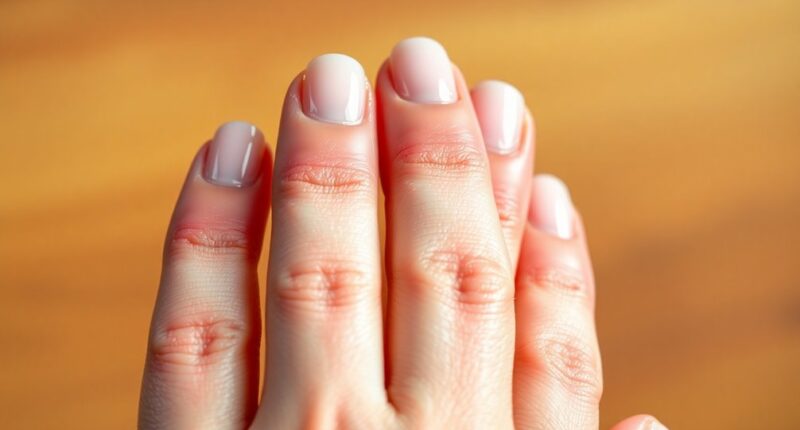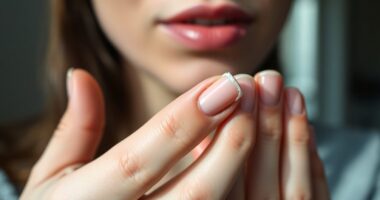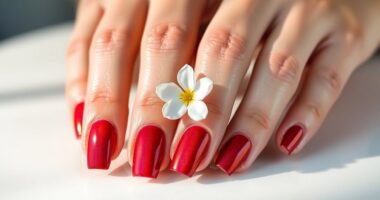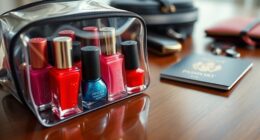Your nails might curve down due to various factors, including nutritional deficiencies, such as iron, or underlying health issues like clubbing or koilonychia. Clubbing is often linked to respiratory or heart conditions, while koilonychia can indicate anemia. Aging can also change nail structure. It's crucial to monitor any significant changes, as they could signal deeper health concerns. If you want more information about maintaining nail health and understanding changes, there's plenty more you can discover.
Key Takeaways
- Downward-curving nails may indicate health issues like clubbing, linked to lung disease or heart problems.
- Nutritional deficiencies, particularly iron deficiency, can lead to changes in nail shape, such as koilonychia.
- Fungal infections can cause nails to thicken and curl downwards over time.
- Aging and genetic factors contribute to natural changes in nail curvature, often without serious implications.
- Significant or sudden changes in nail curvature should prompt a consultation with a healthcare provider for evaluation.
Understanding Nail Curvature
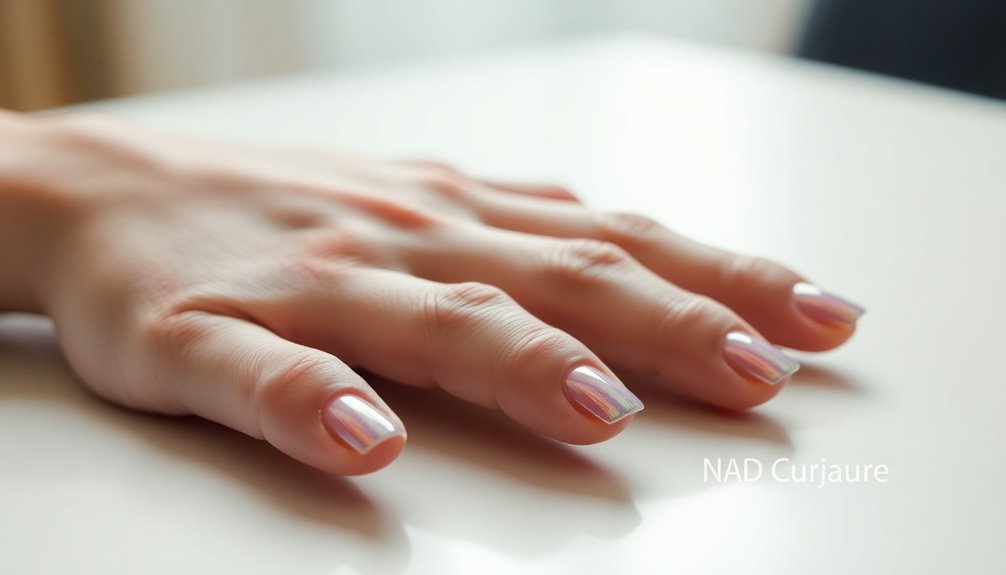
Understanding nail curvature is essential for recognizing potential health issues. Your nails can reveal a lot about your overall health and nail growth patterns.
A gradual downward curve might be harmless, but a dramatic change could indicate serious health problems, such as clubbing. Factors like nutritional deficiencies, especially iron deficiency leading to conditions like koilonychia, can also affect nail curvature.
Monitoring your nails for changes, such as concave or clubbed shapes, is vital, as these alterations may signal underlying health issues. Maintaining proper nail care, including regular trimming and moisturizing, can promote healthier nails and potentially minimize unwanted curvature. Additionally, cultivating an abundance mindset can enhance your overall well-being, which may indirectly support nail health.
Always consult a healthcare professional if you notice significant changes in your nails, as they may require further investigation.
What Causes Nails to Curve Downward?
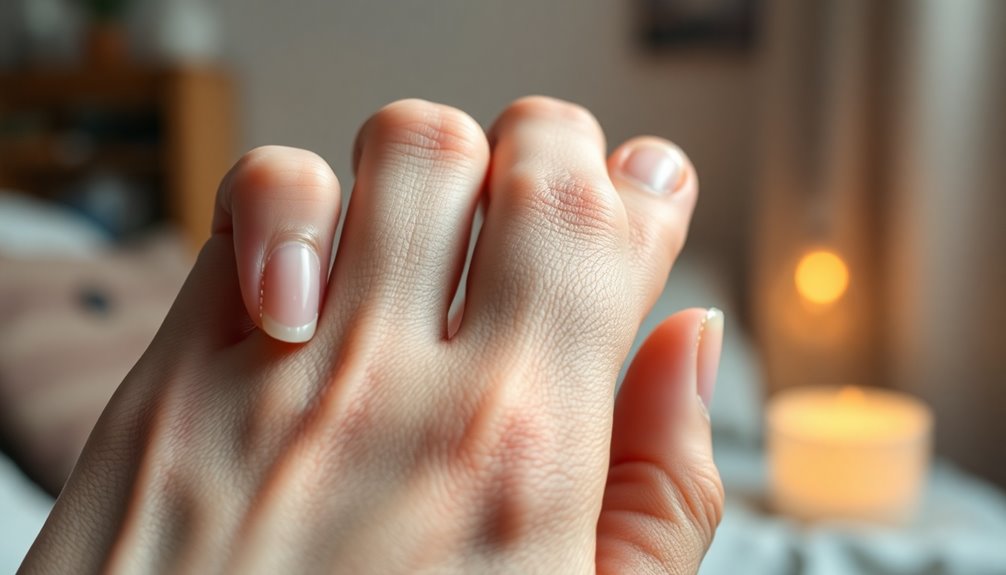
There are several reasons why nails might curve downward, and recognizing these causes can help you understand your health better.
One common cause is clubbing, which can indicate serious health issues like lung disease or heart problems due to a lack of oxygen in your blood.
Another possibility is koilonychia, or spoon nails, often linked to iron deficiency anemia and other nutritional deficiencies.
Fungal infections can also lead to nail abnormalities by causing thickening and curling.
Additionally, as you age, natural biological changes may cause your nails to curve downward.
Genetic factors and autoimmune conditions, such as psoriasis, can further contribute to nail curvature.
Monitoring these changes is essential for maintaining good health. Aromatherapy can stimulate the limbic system, which may help alleviate some stress-related nail issues.
Curved Nails Vs Clubbed Nails
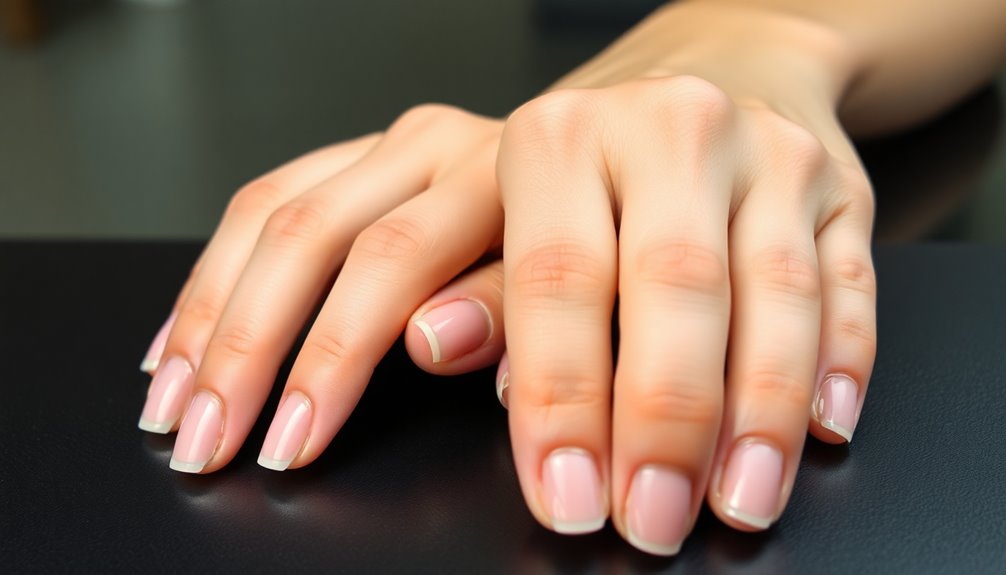
Curved nails and clubbed nails may seem similar at first glance, but they represent different health implications.
Curved nails typically grow downwards gradually and are often benign, resulting from natural growth patterns or mild conditions like nutritional deficiencies.
On the other hand, clubbed nails exhibit a dramatic downward curvature along with swollen fingertips, signaling potential serious health issues.
Clubbing can indicate conditions associated with low oxygen levels in the blood, such as lung diseases or congenital heart defects.
It's essential to monitor nail changes, as significant alterations, especially toward clubbing, may warrant medical evaluation.
Understanding these differences helps you stay alert to your overall health and seek help when necessary. Additionally, changes in nail shape may reflect underlying respiratory or cardiovascular issues, emphasizing the importance of paying attention to your nails as health indicators.
Solutions to Prevent Nails From Curving Downward
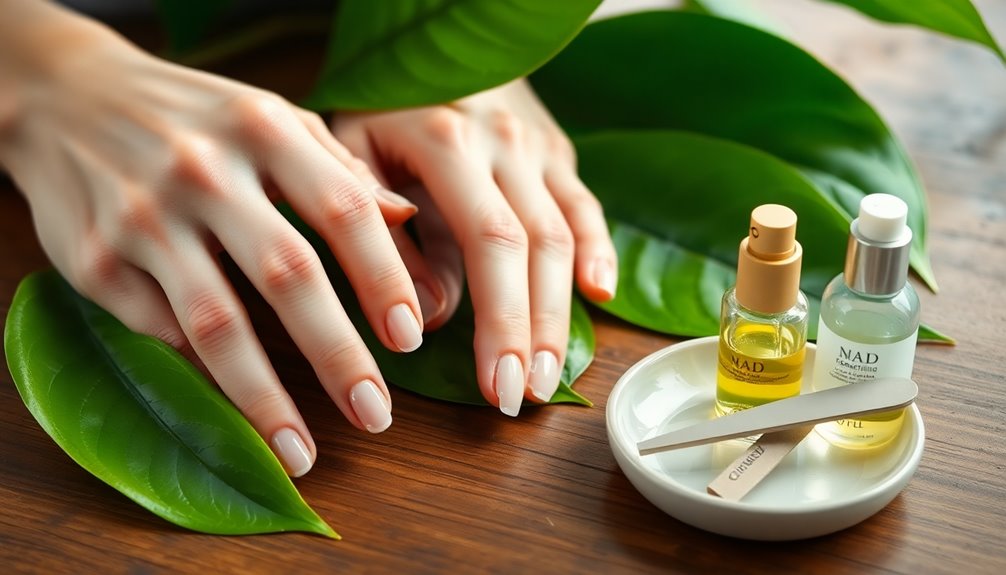
To keep your nails from curving downward, focus on both nail care practices and nutritional support.
Regularly moisturizing, trimming, and filing your nails will help maintain their strength and shape.
Additionally, a balanced diet rich in vitamins and minerals can boost overall nail health. Engaging in safe and durable practices can also contribute to preventing nail issues.
Nail Care Practices
Maintaining healthy nails is essential, especially if you want to prevent them from curving downward. By adopting proper nail care practices, you can enhance their strength and flexibility.
Here are four effective tips:
- Regularly trim and file your nails to maintain their shape and reduce stress on their structure.
- Keep your nails moisturized to improve flexibility and prevent brittleness.
- Avoid harsh chemicals in nail products, like acetone, to protect your nails' integrity.
- If you notice persistent nail changes, consult with a healthcare provider to rule out underlying health issues affecting your overall health. Additionally, air quality considerations can impact your nail health, as poor air quality may lead to skin and nail issues.
Nutritional Support Strategies
Since a well-balanced diet plays an essential role in maintaining healthy nails, focusing on specific nutrients can effectively prevent them from curving downward.
Addressing iron deficiency is important, so include iron-rich foods like red meat, beans, lentils, and fortified cereals in your meals. Vitamins A, C, D, E, and B-complex, along with minerals like zinc and biotin, are critical for nail health.
Regularly consuming omega-3 fatty acids from fish and flaxseeds also boosts nail strength and resilience. Don't forget to stay hydrated, as adequate water intake keeps nails from becoming brittle.
Finally, consider nail-strengthening supplements like biotin, with recommended doses typically between 2,500 to 5,000 micrograms daily, to enhance nail thickness and prevent downward curvature. Additionally, incorporating sensory toys for development can provide a playful way to engage children in activities that promote fine motor skills, which may indirectly benefit overall health, including nail strength.
How to Apply Press on Nails on Curved Nails?
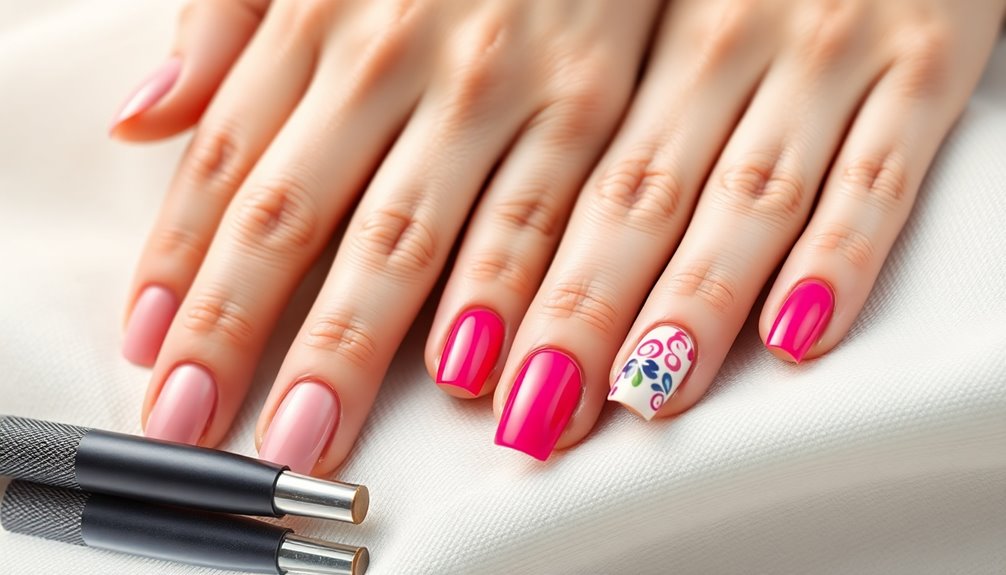
Applying press-on nails on curved nails can be a straightforward process if you follow the right steps. Here's how to achieve a secure and natural look:
- Prep Your Nails: Clean and dry your natural nails using nail polish remover or an alcohol wipe to remove oils.
- Choose the Right Press-On Nails: Select press-on nails designed for curved nail shapes to guarantee a better fit.
- Apply Adhesive: Use a suitable nail adhesive or the sticky tabs provided, spreading it evenly across the nail bed.
- Secure the Press-On Nails: Align the press-on nail with your natural nail's base and press down firmly for 10-15 seconds, focusing on the curved edges. This method is similar to the best vacuums for dust removal which emphasize the importance of selecting the right tools for effective results.
These steps will help you avoid any potential health issues while enhancing your nails' appearance.
When to Seek Help From a Healthcare Provider?
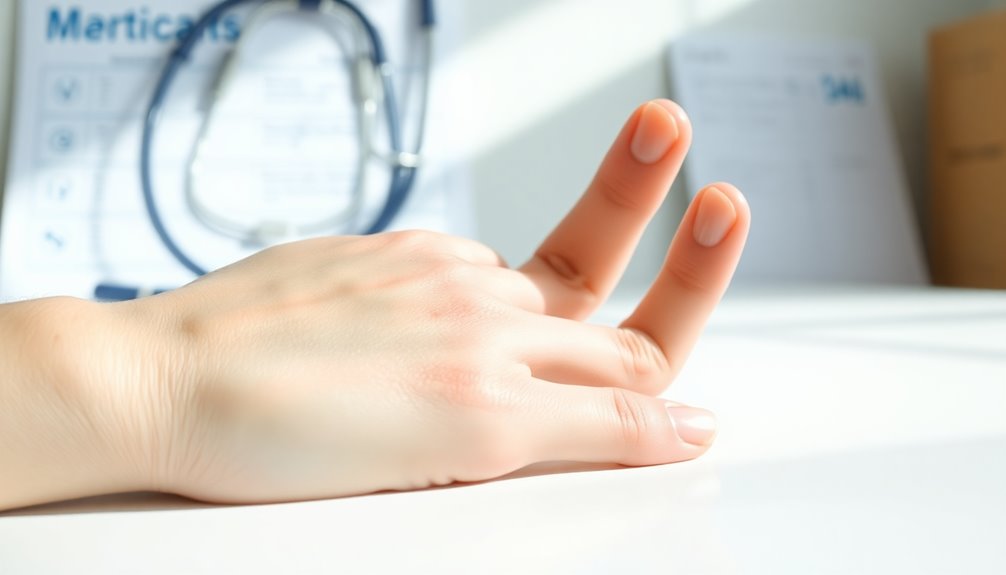
If you notice significant changes in your nail curvature or see color alterations, it's time to seek help.
Persistent symptoms like swelling or pain shouldn't be ignored, as they could signal a deeper issue.
Don't hesitate to consult a healthcare provider to guarantee your health is on track. Additionally, essential oils such as lavender and tea tree oil may provide calming and antimicrobial benefits that could support overall wellness during your recovery.
Significant Nail Changes
When you notice significant changes in your nails, such as a dramatic downward curve or persistent color alterations, it's essential to take those signs seriously.
Changes in nail shape can indicate underlying health issues, including low oxygen levels in your blood. Here are some key signs to watch for:
- Thin, concave nails that suddenly appear.
- Persistent curved nails that develop quickly.
- Accompanying symptoms like fatigue or weakness.
- Changes that last over time without improvement.
If you experience any of these symptoms, consult a healthcare professional for evaluation.
Additionally, underlying health issues may include conditions related to chronic stress, which can also affect your overall well-being.
Early intervention can help identify serious conditions, ensuring that you receive the proper diagnosis and treatment for your nail health concerns.
Don't hesitate to seek help when needed!
Color Alterations in Nails
Significant changes in nail color can be just as alarming as shifts in shape. If you notice color alterations in nails, it's vital to pay attention. Some changes may signal underlying medical conditions that require a health professional's evaluation. Here's a quick reference guide:
| Nail Color | Possible Concern | Recommended Action |
|---|---|---|
| Blue/Green | Insufficient oxygen | Seek immediate evaluation |
| Yellow | Yellow nail syndrome or lung issues | Consult a healthcare provider |
| White (half-and-half) | Chronic kidney disease | Visit a doctor |
| Dark stripes | Possible melanoma | See a dermatologist |
If your nail starts changing color persistently or shows other symptoms, don't hesitate to seek help. Regular health checks for signs of illness can help in early detection of potential health issues.
Persistent Curvature Symptoms
Nail curvature that persists over time can be a sign of underlying health issues, so it's essential to pay attention to any accompanying symptoms. If you're experiencing persistent curvature symptoms, it's time to seek medical advice.
Here are some health tips to reflect upon:
- Color or Texture Changes: Noticeable alterations in your nails may indicate different causes requiring evaluation.
- Fingertip Swelling or Redness: These symptoms could suggest serious conditions like clubbing, linked to heart or lung diseases.
- Sudden Changes: Significant shifts in nail curvature may point to anemia or thyroid disorders.
- Concave Shapes: Nails that no longer grow normally might signal nutritional deficiencies needing professional assessment.
Stay proactive about your nail health!
Identifying Serious Nail Changes
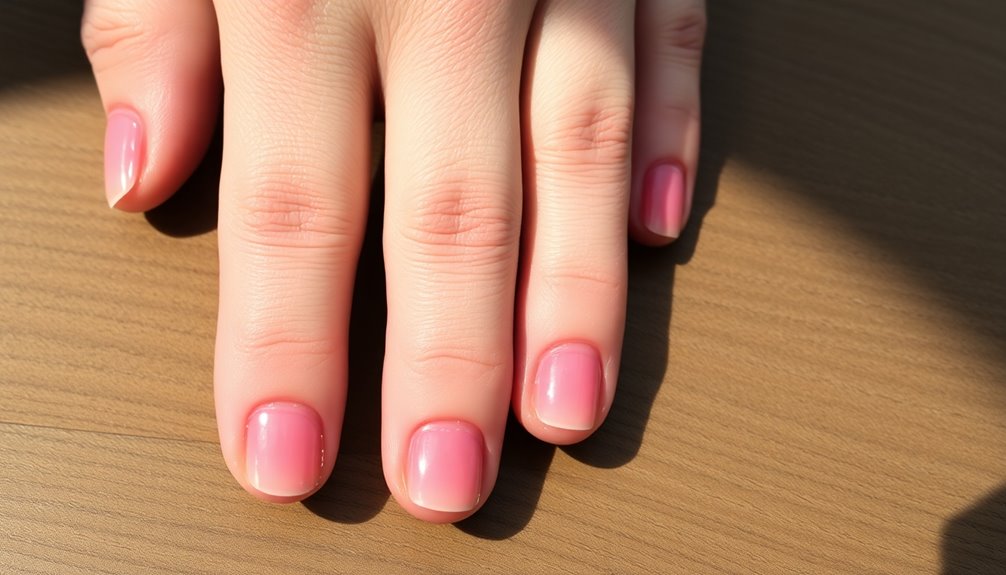
Changes in your nails can be more than just a cosmetic concern; they often signal underlying health issues. When your nails become curved downwards, known as clubbing, it could indicate serious conditions like lung diseases or heart problems. Spoon-shaped nails, or koilonychia, may suggest nutritional deficiencies, such as iron deficiency anemia.
| Nail Change | Possible Health Issue |
|---|---|
| Downward Curving | Lung diseases, heart problems |
| Spoon-Shaped | Iron deficiency anemia, nutritional issues |
| Color Changes | Skin conditions, systemic issues |
Monitor for additional symptoms like color changes or swelling around the nail beds. Significant changes in nail curvature warrant a consultation with a healthcare provider to rule out any serious health concerns.
Conditions Requiring Immediate Attention
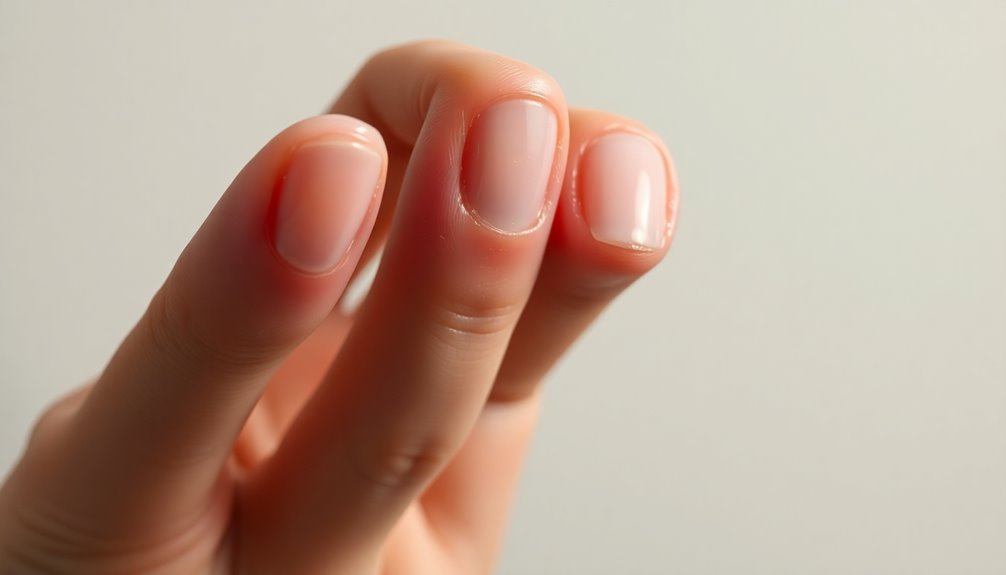
When you notice your nails curving downwards or any transformation in their shape, it's important to pay attention. Curved nails can signal serious health issues, especially if they change suddenly.
Here are conditions that require immediate medical attention:
- Fingertip swelling or discoloration alongside curved nails.
- Persistent curvature that develops quickly, indicating potential systemic diseases.
- Symptoms like fatigue or shortness of breath accompanying nail changes.
- Any signs of nutritional deficiencies related to your nail health.
Acting promptly can help rule out underlying conditions.
Common Myths About Nail Health
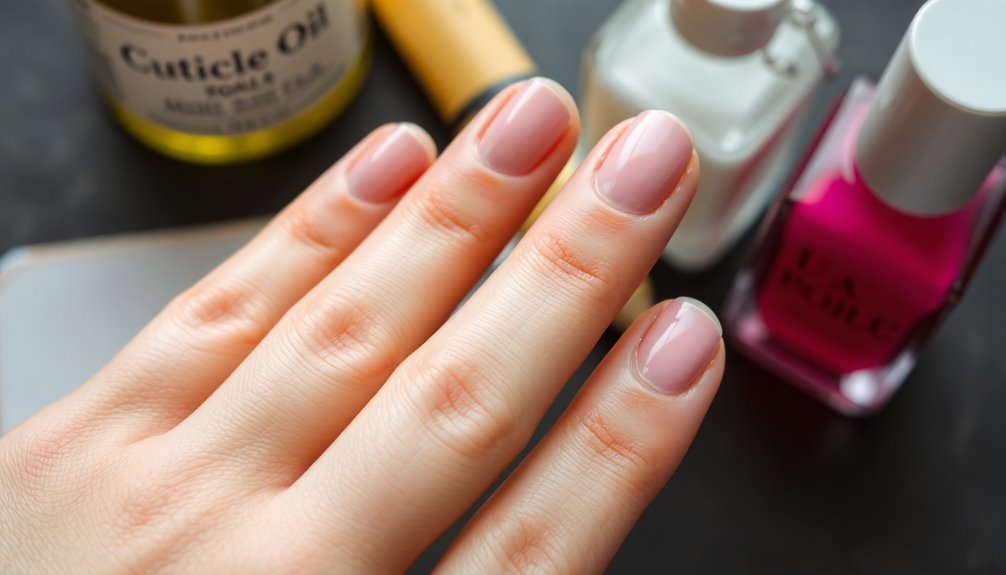
Have you ever wondered about the myths surrounding nail health? Many believe that curved nails always signal poor health, but mild curvature can be a normal variation.
It's also a misconception that nail shape is only influenced by external factors; genetics and health conditions play significant roles. While some curved nails, like concave nails, can indicate iron deficiency, not all are linked to this issue.
Additionally, people often think nail products permanently change nail shape, but your nails will return to their natural growth pattern once removed.
Finally, you might think that nail curvature can't be managed, but with proper nail care, trimming, and a balanced diet, you can promote healthier nail growth and appearance.
Maintaining Overall Nail Health

To keep your nails healthy, you need to practice proper nail care, eat a balanced diet, and schedule regular health check-ups.
Trimming and moisturizing your nails regularly can prevent issues like curling. Plus, a diet rich in vitamins will support nail strength and overall health.
Proper Nail Care
Maintaining your nails isn't just about aesthetics; it's essential for overall nail health. To guarantee your nails stay strong and healthy, focus on proper nail care by following these tips:
- Regularly trim and file your nails gently to maintain their shape and prevent splitting.
- Keep your nails moisturized and consider using nail strengtheners to enhance resilience against bending.
- Avoid harsh chemicals and excessive moisture, which can weaken your nails and lead to curvature issues.
- Schedule routine health check-ups to identify any underlying issues that might affect nail shape.
Balanced Diet Importance
A balanced diet plays a pivotal role in keeping your nails healthy and strong, as the nutrients you consume directly impact their growth and appearance. Nutritional deficiencies, particularly in iron, biotin, and protein, can weaken your nails and lead to undesirable changes like curvature.
To support healthy nail growth, you should incorporate iron-rich foods such as leafy greens, beans, and red meat into your meals. Additionally, essential fatty acids found in nuts and fish help maintain nail hydration and strength, reducing the risk of brittleness and curvature.
Regular Health Check-ups
Healthy nails are often a reflection of your overall well-being, and regular health check-ups play an important role in monitoring this aspect. By attending these appointments, you can effectively manage your nail health and catch potential issues early.
Here are four key benefits of regular health check-ups:
- Identify deficiencies: Detect iron deficiency or other nutrient shortages that affect nail growth.
- Monitor changes: Discuss any noticeable nail changes, such as shape or color, with your healthcare provider.
- Blood tests: Assess nutrient levels vital for healthy nails, including iron and vitamins.
- Proactive management: Keep a record of nail changes to facilitate timely interventions and lifestyle adjustments.
Prioritizing your health check-ups can greatly enhance your nail integrity and overall wellness.
Frequently Asked Questions
Why Do Fingernails Curl Downward?
Fingernails can curl downward for several reasons. You might be experiencing changes due to nutritional deficiencies, particularly in iron or essential vitamins.
Aging can also play a role, as your nails naturally change over time. Additionally, certain health conditions, like lung or heart issues, may cause more dramatic nail curvature.
It's important to keep an eye on your nails and consult a healthcare provider if you notice significant changes.
What Deficiency Causes Nails to Bend Down?
Oh sure, your nails are just trying to start a trendy new fashion statement by bending down!
But in reality, this could signal a deficiency, particularly in iron. If you're low on iron or biotin, your nails might just be throwing a tantrum.
Conditions like anemia can also play a part, making your nails look like they're auditioning for a sad movie.
Keep an eye on your diet; your nails might need some TLC!
What Do Iron Deficiency Nails Look Like?
When you have iron deficiency, your nails can take on a concave or spoon-like shape, known as koilonychia.
You might notice that they appear flatter than usual and can even hold a drop of water on their surface.
This change is often more noticeable on your fingernails than on your toenails.
If you're experiencing this, it's a good idea to consult a healthcare professional for advice and potential treatment.
How Do I Make My Nails Not Curve Down?
As the saying goes, "A stitch in time saves nine."
To keep your nails from curving down, start by maintaining a balanced diet rich in vitamins and minerals, especially iron.
Regularly file and trim your nails to avoid excess length.
Use nail strengtheners to boost resilience, and steer clear of harsh chemicals.
If you notice significant changes, don't hesitate to consult a healthcare provider to address any underlying issues.
Your nails will thank you!
Conclusion
In conclusion, understanding your nails' curvature, knowing the causes, and recognizing serious changes can empower you to take charge of your nail health. By preventing downward curves, applying press-on nails effectively, and dispelling myths, you can maintain beautiful nails. Stay informed, stay proactive, and stay healthy. Remember, your nails reflect not just your beauty but your overall well-being, so treat them with care, nurture them with knowledge, and watch them thrive!
